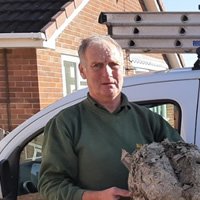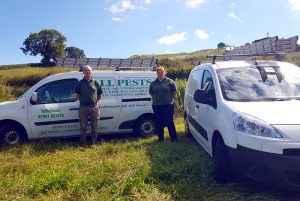Summer brings longer days, warmer weather, and unfortunately for many homeowners, increased bee activity. While bees are vital pollinators and a protected species in many areas, having a nest or swarm near your home or garden can be alarming and even dangerous, especially for those with allergies or children. We want to tell you how to get rid of them safely.
If you’ve noticed a growing cluster of bees or frequent buzzing in one area of your property, we are here to give you practical advice and guidance on what to do next.


Step 1: Identify What You’re Dealing With
Not all bee problems are the same. Knowing whether you’re seeing a swarm or a nest can help you determine how urgent the situation is.
- Swarm: A bee swarm is a temporary cluster of bees, often hanging from a tree branch, fence, or wall. Swarming bees are typically calm and just looking for a new home. Swarms usually move on within a day or two.
- Nest (Hive): A bee nest is a more permanent structure where a colony has settled. These can appear inside wall cavities, chimneys, attics, garden sheds, or trees. If bees are coming and going from the same spot regularly, it’s likely a nest.
Step 2: Understand Why Bees Are Nesting Near You
Bees prefer quiet, sheltered areas with access to food (flowers) and water. Common nesting spots include:
- Roof eaves and wall cavities
- Compost bins or garden boxes
- Inside sheds, garages, or birdhouses
- Gaps in brickwork or chimneys
Step 3: What NOT to Do
It’s tempting to try and handle a bee issue yourself, but this can be extremely dangerous.
Avoid the following:
- Spraying insecticides or household chemicals, this can result in a costly fine.
- Blocking hive entrances (this can drive bees inside your home)
- Trying to knock down or move the nest on your own
Agitating a colony increases the risk of stings and uncertainty of how the hive/swarm may react together.
Step 4: How to get rid of Bees safely
- Keep a safe distance, especially from children and pets.
- Don’t panic, and try to deal with the nest yourself.
- Observe the location and activity from afar so you can report it accurately.
- Contact all pests, we specialise in bee nest/hive removal, we’ll assess whether removal or relocation is necessary.
Step 5: Preventing Future Bee Nests
Once the bees are safely removed, take steps to prevent them from returning:
- Seal cracks and holes around your home (especially in spring)
- Fit mesh over vents and chimneys
- Keep compost bins and pet food containers sealed
- Trim overgrown trees and shrubs near buildings
When to Call the Experts
If the bees are nesting in a difficult location, such as inside a wall or roof space or you just want to get rid of the bees safely, it’s best to seek immediate professional help.
